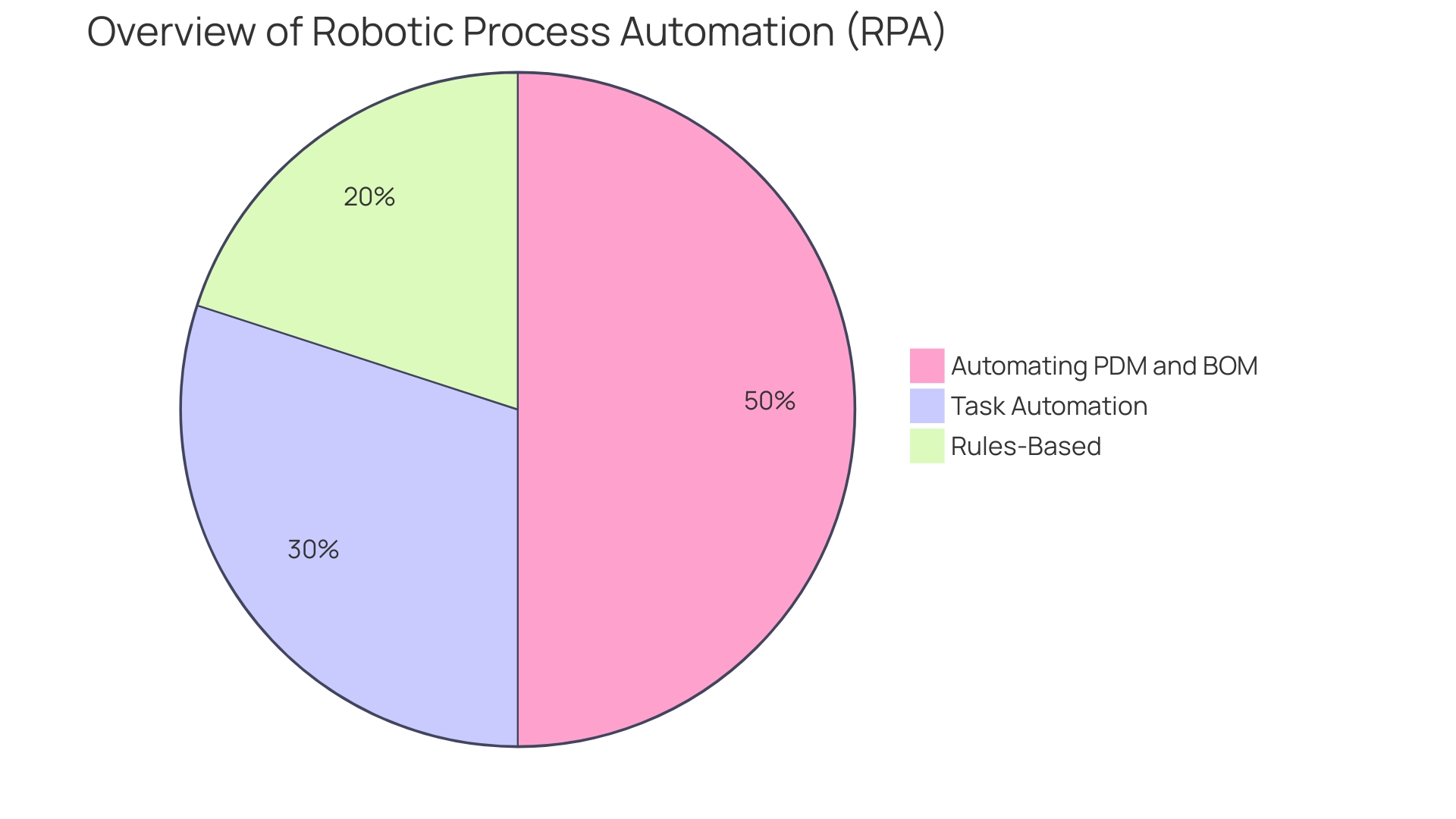Introduction
Robotic Process Automation (RPA) is revolutionizing the way organizations approach mundane and rule-based tasks. By deploying software robots, or ‘bots’, that mimic human interactions with digital systems, RPA automates functions such as data entry, data extraction, and document processing. This not only enhances operational efficiency but also minimizes human error, leading to a more streamlined and error-free work environment.
In industries ranging from banking to healthcare to hospitality, RPA has demonstrated its scalability and effectiveness in improving processes and outcomes. However, it’s important to note that RPA requires ongoing management and human oversight to ensure stability and effectiveness. With the majority of companies engaging in repetitive tasks that can benefit from automation, RPA stands as a cornerstone in the digitalization journey, empowering organizations to optimize processes and harness new technological capabilities.
What is RPA Software?
Robotic Process Automation (RPA) represents a transformative leap in the way organizations tackle mundane and rule-based tasks. This technology deploys software robots, or ‘bots’, that imitate interactions with digital systems, performing a wide array of functions across different applications and interfaces. The core of RPA lies in its ability to automate tasks such as data entry, data extraction, and document processing, which are typically executed by workers. By integrating RPA, companies are not only enhancing their operational efficiency but also minimizing the scope of human error, leading to a more streamlined and error-free work environment.
Illustratively, M&T Bank’s embrace of digital transformation, which is crucial in an industry with stringent regulatory and security demands, highlights the necessity for technologies like RPA that can uphold high-quality standards in software code. Surrey County Council’s initiatives, aimed at improving services for over a million residents, demonstrate the scalability of RPA and its role in enhancing both citizen and employee experiences. Likewise, the hospitality sector, as proven by the partnership between Louvre Hotels Group and RobosizeME, has experienced significant operational enhancements and time savings with the adoption of automated processes in rate code management.
As mentioned by the CTO and Co-Founder of Reveille Software, the process of automating tasks is not something that can be implemented and forgotten; it requires ongoing management and oversight from individuals to ensure stability and effectiveness. This is particularly relevant when considering the integration of RPA within complex systems such as Epic and Cerner in healthcare, which require secure and up-to-date patient information management. The significant revenue growth and productivity enhancements reported in Forrester’s Total Economic Impact study further validate the tangible benefits of intelligent technological assistance when complemented by human collaboration. This human-digital worker synergy is paramount to maximizing results and achieving a compound annual growth rate of 5.4%.
In a wider view, 94% of companies participate in repetitive tasks that can gain from mechanization, and it has already enhanced jobs for 90% of knowledge workers. With 83% of IT leaders confirming that workflow automation is essential for digital transformation, RPA stands as a cornerstone in the digitalization journey, enabling companies to harness new technological capabilities and optimize processes from inception to completion.
How Does RPA Software Work?
Robotic Process Automation (RPA) is transforming the way organizations handle their operations. At its core, RPA utilizes software ‘bots’ to automate repetitive and rule-based tasks that traditionally require manual intervention. By emulating interactions with various software applications, these bots are capable of executing a wide range of activities, such as logging into systems, extracting and managing data, populating forms, and performing calculations. What sets RPA apart is its ability to integrate with email or chat interfaces, enabling bots to communicate and collaborate with human users and even other bots.
These advanced software bots are not only programmable to operate autonomously on a set schedule but can also be activated through specific events or manual initiation. This flexibility allows them to adapt to the dynamic needs of businesses. By automating repetitive tasks, companies experience significant enhancements in efficiency and productivity. Moreover, in industries such as healthcare, where legacy systems pose significant security risks, RPA offers a secure and compliant solution for adopting new digital technologies. In fact, approximately 73% of healthcare organizations have been reported to rely on legacy systems, which RPA can help modernize while maintaining high security standards.
The implications of RPA extend beyond simple task; they also play a pivotal role in enhancing customer and employee experiences. For example, Surrey County Council, which offers vital services to more than a million residents, utilizes technology to enhance service delivery and operational outcomes. Moreover, the incorporation of RPA with generative AI offers the potential of significantly expanding the range of applications for the technology, as mentioned by prominent figures in the field. This synergy can lead to a reduction in operating costs and a significant increase in productivity, providing companies with a competitive edge. The strategic implementation of RPA, backed by intelligent automation, has demonstrated a revenue growth of 73% of overall Net Present Value (NPV) benefit and a 5.4% compound annual growth rate (CAGR) over three years for those who adopt these technologies.
Key Benefits of RPA Software
Robotic Process Automation (RPA) has transformed the technological landscape, offering companies a powerful tool to enhance operational efficiency. By automating mundane and repetitive tasks, RPA liberates employees, allowing them to dedicate their time to more complex, strategic initiatives that add value to the business. For instance, healthcare providers have seen substantial advancements in patient care management and data handling by integrating RPA with electronic medical record systems like Epic and Cerner.
The accuracy and reliability of data are improved due to the precision of RPA, which greatly reduces the risk of error caused by individuals. In the banking sector, where M&T Bank has embraced digital transformation, maintaining high standards of data security and regulatory compliance is paramount. RPA plays a critical role in ensuring these standards are consistently met while streamlining operations.
Cost savings are another compelling benefit of RPA. By optimizing the use of human resources and enhancing productivity, organizations can achieve a more economical operational model. Research, like the Total Economic Impact methodology created by Forrester Research, have demonstrated that firms investing in intelligent technology can anticipate a revenue growth of 73% of overall net present value (NPV) benefit and a 5.4% compound annual growth rate (CAGR) over three years.
Moreover, RPA’s scalability is a vital feature for businesses like TBC Bank, which has evolved from a local business center to Georgia’s leading financial institution. As companies expand or face changes in demand, RPA enables them to effortlessly adapt their operational processes without significant disruptions.
Despite the clear advantages, it’s important to remember that automation isn’t a ‘set it and forget it’ solution. As the CTO and Co-Founder of Reveille Software points out, monitoring, management, and upgrades are essential to maintain stability and performance. Nonetheless, RPA represents a significant stride forward in the pursuit of operational excellence, driving efficiency and fostering innovation across various industries.

Elements of an RPA Framework
Robotic Process Automation (RPA) stands as a transformative force in the landscape of operational efficiency. To exploit its complete potential, companies must create a detailed structure that addresses several crucial factors. This starts with pinpointing and selecting the right processes, a task that mirrors the intricate assessments conducted by healthcare institutions when adopting digital technologies. For instance, the NHS’s discovery of existing but unrecognized technologies within its trust underscores the importance of thorough evaluation before introducing new solutions.
While designing RPA solutions, we must also build a framework and operating model that align with the goals of the company. Governance and oversight provide the necessary checks and balances to ensure compliance and proper alignment with business objectives, akin to the governance structures found in healthcare systems like those managed by LGI Healthcare Solutions and Boston Software Systems.
Moreover, the operating model for RPA programs must be scalable and adaptable, reflecting the innovative approaches in retail such as the checkout-free stores enabled by Zippin technology at Dublin Airport. This model demonstrates the smooth integration of automation in daily operations, a concept that is becoming more and more important as companies aim to improve both customer and employee experiences.
In summary, when each element of the RPA implementation framework is meticulously addressed, organizations can lay a solid groundwork for their RPA initiatives, akin to the methodical approach Surrey County Council takes in servicing its community. This foundation not only supports the effective deployment of RPA technology but also catalyzes the realization of its myriad benefits, from operational improvements to heightened service standards.
Conclusion
In conclusion, Robotic Process Automation (RPA) is revolutionizing organizations by automating mundane tasks and improving operational efficiency. By deploying software robots that mimic human interactions with digital systems, RPA streamlines processes such as data entry and document processing, reducing human error and creating a more efficient work environment.
RPA has proven its scalability and effectiveness in various industries, including banking, healthcare, and hospitality. Companies like M&T Bank, Surrey County Council, and Louvre Hotels Group have experienced significant operational improvements and time savings through automation.
However, it’s important to note that RPA requires ongoing management and human oversight for stability and effectiveness. Collaboration between humans and bots is crucial for maximizing results and achieving growth.
With the majority of companies engaging in repetitive tasks that can benefit from automation, RPA is a cornerstone in the digitalization journey. It empowers organizations to optimize processes, harness new technological capabilities, and enhance operational efficiency.
Integrating RPA allows organizations to free up employees from mundane tasks, reduce the risk of human error, and achieve cost savings. RPA’s scalability enables businesses to adjust their automation efforts as needed without major disruptions.
To harness the full potential of RPA, organizations must establish a meticulous framework. This includes selecting the right processes, aligning with business objectives, implementing governance and oversight, and creating a scalable and adaptable operating model.
In summary, RPA offers practical solutions for organizations seeking to enhance operational efficiency. With ongoing management and human oversight, RPA can drive efficiency, foster innovation, and optimize processes across industries. It is a transformative technology that empowers organizations to embrace digitalization and unlock new possibilities for growth.

